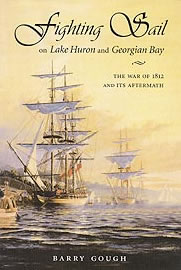 This information has been archived for reference or research purposes.
This information has been archived for reference or research purposes.
Archived Content
Information identified as archived on the Web is for reference, research or recordkeeping purposes. It has not been altered or updated after the date of archiving. Web pages that are archived on the Web are not subject to the Government of Canada Web Standards. As per the Communications Policy of the Government of Canada, you can request alternate formats on the "Contact Us" page.
BOOK REVIEWS
FIGHTING SAIL ON LAKE HURON AND GEORGIAN BAY: THE WAR OF 1812 AND ITS AFTERMATH
by Barry Gough
Annapolis, MD: Naval Institute Press. 215 pages, $US 32.95.
(Distributed in Canada by Vanwell Press)
Reviewed by James Pritchard

For more information on accessing this file, please visit our help page.
Anyone who has visited the charmingly restored buildings of the Royal Navy establishment at Penetanguishene, Ontario and wondered what ever moved the British to build them can now have a clear answer. This book is the fourth written during the last half dozen years that has transformed our knowledge and understanding of the maritime and military struggle for the Great Lakes during the War of 1812, that curious contest that both Canadians and Americans believe they won and that the British view as an embarrassment. The other titles are Robert Malcolmson, Lords of the Lake: The Naval War on Lake Ontario, 1812-1814, (Toronto, 1998), David Curtis Skaggs and Gerard T. Altoff, A Signal Victory, The Lake Erie Campaign, 1812-1813, (Annapolis, 1997), and John Sugden, Tecumseh, A Life, (New York, 1997).
Barry Gough, Canada’s most prolific naval historian, has now presented an excellent account of the struggle for the Upper Lakes that followed the famous Battle of Lake Erie. Gough explains why, despite their great naval victory, the Americans failed to exploit their preponderant position in the west during the last year of the war. He sets the stage very well in the introduction and the first two chapters, clearly outlining the British strategy to defend Upper Canada and the fur trade in the North American interior. He recounts briefly the daring initiatives and desperate measures carried out by British commanders who captured Detroit and Fort Michilimackinac in 1812 and the failure of the same aggressive forward strategy on Lake Erie in 1813. Gough devotes the remainder of his narrative to the 1814 campaign and its aftermath. The four main chapters include accounts of the escape of HMS Nancy, the creation of Fort Willow between Lake Simcoe and the forks of the Nottawasaga River which flows into Georgian Bay, the building of a fort near the mouth of the same river, the British-led Canadian-Indian attack deep into present-day Wisconsin and the capture of Prairie du Chien on the Mississippi River, the successful American attacks at Nottawasaga and Sault Ste. Marie, and Lieutenant Worsley’s daring cutting-out expedition that netted the British two American schooners when they had no sailing craft at all on the Upper Lakes. Gough’s final three chapters are devoted to the war’s aftermath, the search for security, the changing strategy that led to building the naval establishment at Penetanguishene and the eventual demilitarization of the Great Lakes. The story is well told throughout.
The maps provide excellent aids to comprehension. Gough’s account is balanced and the details are always related to the big picture of international diplomacy and military strategy. This book should appeal to anyone interested in daring deeds by small forces, Canada’s military and naval history, and the military strategy of an earlier day.
![]()
Dr. James Pritchard is Professor Emeritus of History at Queen’s University in Kingston.






